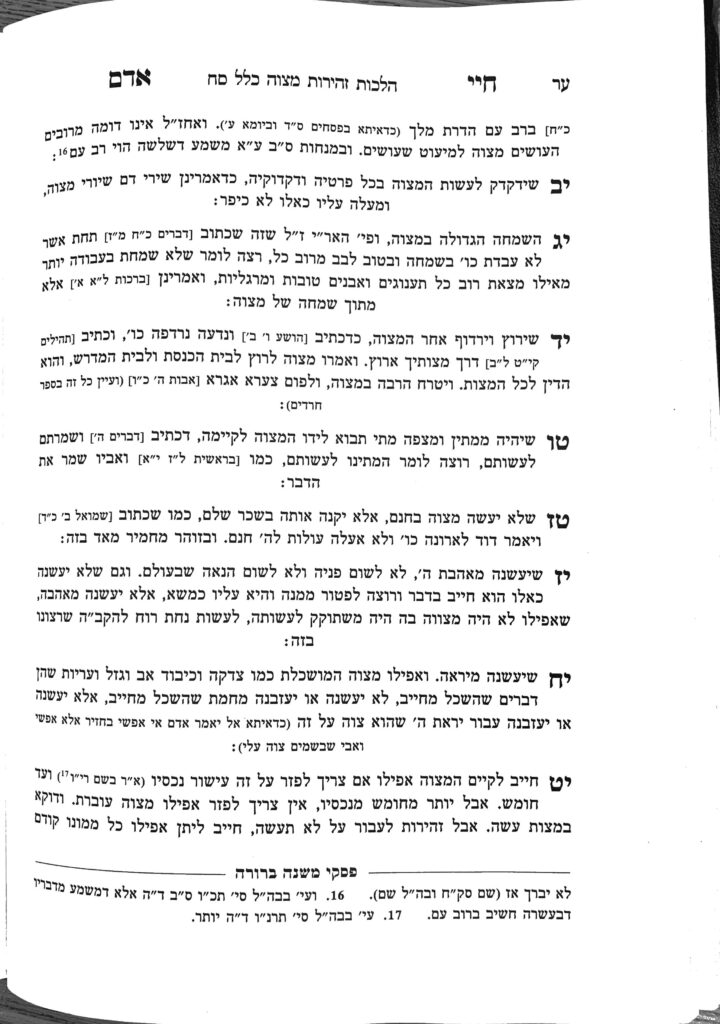We are continuing in siman 19, which discusses spending money on mitzvos. We learned that one is chayav to spend up to one tenth, or one fifth, to fulfill a mitzvah. The Chayei Adam clarifies that this spending limit applies to fulfilling a mitzvah. To avoid transgressing an aveirah, the Chayei Adam writes that one is chayav to spend all of their money to avoid the aveirah.
The Chofetz Chaim gives the example of an employee who is told by their boss that they must speak lashon hara in order for the boss to identify the source of a problem in their company. The boss threatens that the employee will lose their job if they do not speak the lashon hara. The employee is chayav to give up their job, even though it is more than one fifth of their money, to avoid the lashon hara.
Although it would be muttar to transgress aveiros for pikuach nefesh, the assumption of the poskim is that losing one’s job is not considered pikuach nefesh, because one can beg, borrow money, or find remedial jobs to avoid the pikuach nefesh.
This issue was part of the mistake people made in America at the beginning of the previous century regarding working on Shabbos. Although we cannot understand the level of their challenge, it is clear that working on Shabbos under the cover of pikuach nefesh is not a valid halachic argument. It is an emotional thought process, but it is not a halachic argument.
There is a lav in the Torah prohibiting feeding non-kosher food to a Jew. Thus, if a Jewish nurse in a hospital is told to feed a Jew non-kosher, it is a difficult halachic question because they are transgressing lifnei iver (placing a stumbling block) and lo saachilum (feeding non-kosher to a Jew) Arguably they would be chayav to give up their job to avoid these transgressions. Similarly, if a person holds various licenses, and may lose their license if they refuse to perform procedures which are halachically assur, they would be chayav to give up their license to avoid performing the procedures. This concept is extremely weighty, but without a heter of pikuach nefesh, a person is chayav to give up all of their money to avoid transgressing an issur. The pasuk says b’chol meodecha, one must serve Hashem with all of their money, and this challenge falls under the pasuk.
In siman 656, the Pri Megadim discusses the definition of an asei and lo saasei. Clearly, there are many mitzvos in the Torah where there is no question that a mitzvas asei is defined by performing an action, and a lo saasei is defined by actively refraining from an action.
However, there are also mitzvos where the mitzvas asei is to not act, as opposed to action, known as issur aseh. And some Lo saasei are commands to act (for example, lo saamod al dam reiache, don’t stand idly by when someone is in danger). The Pri Megadim understands that the definition of asei and lo saasei is not whether the mitzvah is classified as an asei or lo saasei, per se, but rather as action versus inaction. It is only when there is an inaction on the part of the person (such as not wearing tefillin) that the one fifth exemption applies, but whenever one must perform an action, one must give up all of their money to avoid the action.
Summary
- A person must spend up to one tenth, or one fifth, of their money in order to fulfill a mitzvah. A person must give up all of their money to avoid performing an aveirah.
- Mitzvah and aveirah are not defined by asei and lo saasei, but inaction (mitzvah) and action (aveirah).
- The only exception is pikuach nefesh, in which pikuach nefesh supersedes the aveirah.



